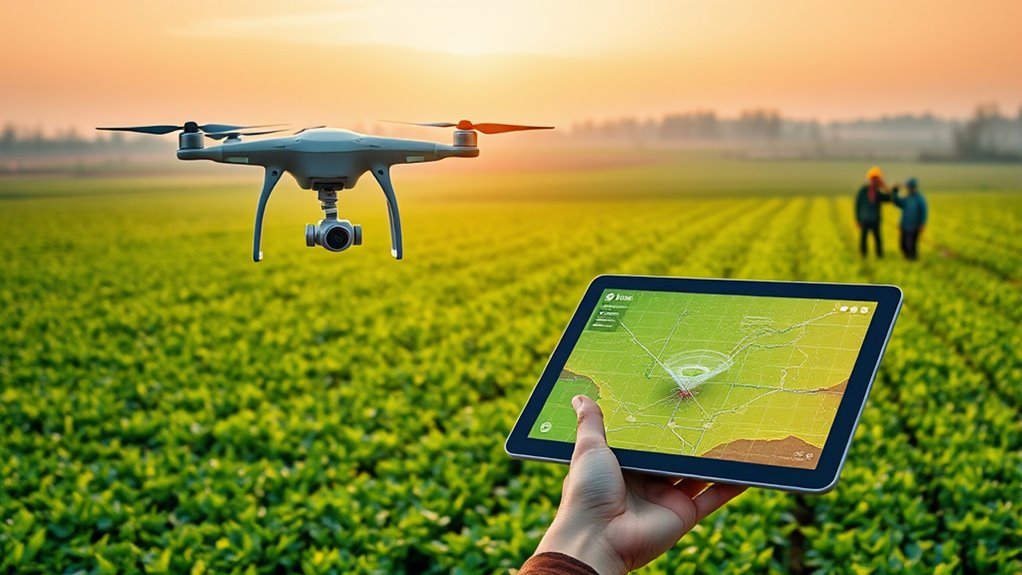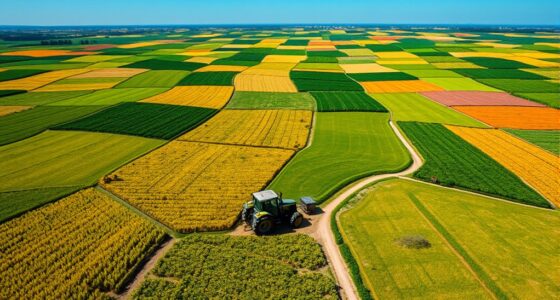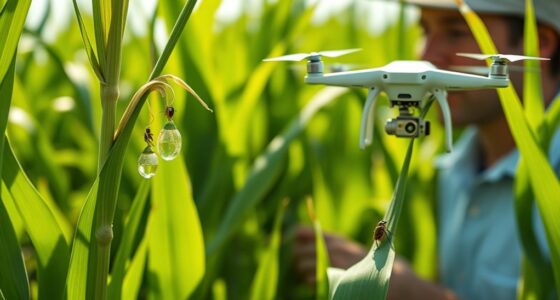Digital twins in agriculture create real-time virtual models of your farm, mirroring actual conditions through data from sensors, drones, and other sources. They help you optimize irrigation, monitor crops closely, and simulate different scenarios to make better decisions. These tools enable resource conservation, early issue detection, and improved crop management. By leveraging high-quality data, you’ll gain deeper insights into your farm operations and discover how to work smarter and more sustainably. Continue exploring to learn how these innovations can transform your farming.
Key Takeaways
- Digital twins create real-time virtual representations of farm environments, enabling better monitoring and decision-making.
- They integrate sensor, drone, and weather data to optimize irrigation, crop health, and resource use.
- Digital twins allow virtual testing of planting strategies and resource allocations to reduce risks and improve outcomes.
- They facilitate early detection of pests, diseases, and stress factors, supporting timely intervention.
- High-quality data ensures accurate models, empowering sustainable and profitable farm management through advanced analytics.

Have you ever wondered how technology is transforming farming practices today? One of the most exciting developments is the use of digital twins—virtual models that replicate real-world farm environments in real time. These digital replicas allow you to simulate, analyze, and optimize your farming operations with unparalleled accuracy. By integrating data from sensors, drones, and other sources, you can create a dynamic digital twin that reflects the current state of your fields, giving you a powerful tool to make smarter decisions.
With digital twins, precision irrigation becomes more effective. Instead of relying on guesswork or fixed schedules, you can monitor soil moisture levels and weather conditions continuously through the twin. This allows you to adjust water application precisely where and when it’s needed, conserving resources and reducing costs. For example, if your digital model detects that a section of your field has sufficient moisture, you can skip watering that area, preventing over-irrigation and runoff. Conversely, if a dry spot is identified, the system can recommend targeted watering, improving crop health and yield. This level of control not only boosts efficiency but also promotes sustainable water use, which is *essential* in areas facing water scarcity.
Digital twins optimize irrigation by monitoring moisture and weather, conserving resources and enhancing crop health.
Crop monitoring is another area where digital twins shine. By integrating real-time data from drones and ground sensors, the virtual model provides a *detailed* view of crop health, growth stages, and potential issues like pests or diseases. Instead of walking through fields or relying solely on visual inspections, you get *in-depth* insights directly from the digital twin. If the model detects signs of stress in a particular area, you can intervene quickly, whether that’s adjusting nutrient levels, applying treatments, or modifying irrigation. This proactive approach minimizes crop loss and maximizes productivity. Plus, continuous monitoring helps you track the effectiveness of your management strategies over time, enabling data-driven decisions that improve your overall farm performance.
The power of digital twins lies in their ability to simulate future scenarios as well. You can experiment with different planting schedules, crop varieties, or resource allocations within the virtual environment before making changes on the ground. This not only saves time and resources but also reduces risks associated with unfamiliar practices. As technology advances, integrating AI and machine learning into digital twins will further enhance their predictive capabilities, helping you anticipate weather patterns, pest outbreaks, and market demands.
Additionally, understanding the importance of high-quality data in creating accurate digital twins ensures reliable insights and better decision-making. In essence, digital twins are revolutionizing farm management by providing a virtual lens through which you can see and control every aspect of your operation. Whether it’s fine-tuning precision irrigation or enhancing crop monitoring, these virtual models empower you to farm smarter, more sustainably, and more profitably in today’s rapidly changing agricultural landscape.
Frequently Asked Questions
How Cost-Effective Are Digital Twins for Small Farms?
Digital twins can be quite cost-effective for small farms by helping you identify inefficiencies and optimize resource use, leading to significant cost reduction. While initial investment might seem high, the long-term benefits include better decision-making and increased productivity. You’ll save money on inputs and maintenance, making digital twins a smart investment that enhances farm management without overwhelming your budget. Overall, they offer a valuable balance of costs and benefits for small farms.
What Are the Technical Requirements to Implement Digital Twins?
Think of implementing digital twins as building a bridge between your farm and the digital world. You’ll need sensor integration to gather real-time data and robust data analytics to interpret that info. This involves hardware like sensors, connectivity tools, and software capable of processing large datasets. Ensuring reliable internet and compatible devices is essential, so you can transform farm data into actionable insights, making your management smarter and more efficient.
How Do Digital Twins Improve Crop Yield Predictions?
Digital twins improve crop yield predictions by integrating sensors that collect real-time data on soil, weather, and crop health. You can then use data analytics to analyze this information, identify patterns, and forecast yields more accurately. This continuous flow of data helps you make informed decisions, optimize resource use, and increase productivity. Sensor integration and advanced analytics are essential for creating precise, dynamic models that reflect your farm’s current conditions.
Are Digital Twins Adaptable to Different Types of Agriculture?
Did you know that over 70% of farms grow multiple crop types? Digital twins are adaptable across various agriculture types because they can account for crop diversity and soil variability. By customizing virtual models to specific farm conditions, you can optimize practices no matter your crop selection or land differences. This flexibility helps you make informed decisions, improve yields, and efficiently manage resources across diverse agricultural settings.
What Are the Privacy Concerns With Digital Twin Data?
You should be aware that privacy concerns with digital twin data include potential breaches of data security and misuse of sensitive information. Farmers and stakeholders must guarantee robust data security measures are in place and follow clear privacy policies. By doing so, you protect farm data from unauthorized access, maintain trust, and comply with regulations, ensuring that digital twin technology benefits your farm without compromising privacy.
Conclusion
Embracing digital twins in agriculture can transform your farm management, making it more efficient and responsive. By creating virtual models, you can anticipate issues before they arise and optimize your resources. Remember, a stitch in time saves nine—investing in digital twins now can save you time and money later. As technology advances, staying ahead means harnessing these innovative tools to grow healthier crops and a more sustainable future.








